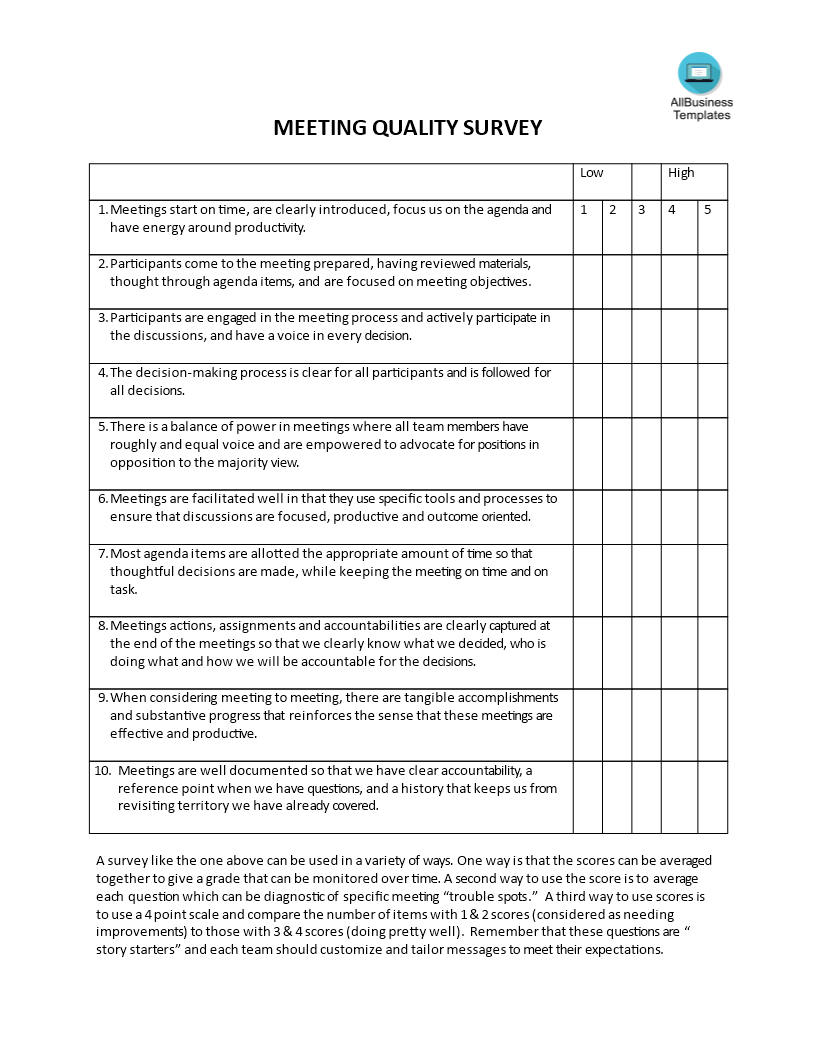Meeting Quality Survey
Save, fill-In The Blanks, Print, Done!

Download Meeting Quality Survey
Microsoft Word (.doc)Or select the format you want and we convert it for you for free:
- This Document Has Been Certified by a Professional
- 100% customizable
- This is a digital download (86 kB)
- Language: English
- We recommend downloading this file onto your computer.
How to create a Quality Meeting Survey? How meeting quality affects company productivity? An easy way to start your survey is to download this Meeting Quality Survey template now!
We provide this Meeting Quality Survey template to help professionalize the way you are working. Our business and legal templates are regularly screened and used by professionals. If time or quality is of the essence, this ready-made template can help you to save time and to focus on the topics that really matter!
To prevent people spent their minutes in a wasteful meeting, they eat into solo work that’s essential for creativity and efficiency. Chopped-up schedules interrupt deep thinking, so people come to work early, stay late, or use weekends for quiet time to concentrate. And dysfunctional meeting behaviors are associated with lower levels of market share, innovation, and employment stability. To get a clearer view of how meetings are affecting your group, use surveys or interviews to gather data and impressions from every individual. That will help you gauge the full extent of the problem: You’ll learn how much resentment is bubbling under the surface and how much work isn’t getting done during the day.
A survey like the one above can be used in a variety of ways. One way is that the scores can be averaged together to give a grade that can be monitored over time.
1. Meetings start on time, are clearly introduced, focus us on the agenda and have energy around productivity.
2. Participants come to the meeting prepared, having reviewed materials, thought through agenda items, and are focused on meeting objectives.
3. Participants are engaged in the meeting process and actively participate in the discussions, and have a voice in every decision.
4. The decision-making process is clear for all participants and is followed for all decisions.
5. There is a balance of power in meetings where all team members have roughly and equal voice and are empowered to advocate for positions in opposition to the majority view.
6. Meetings are facilitated well in that they use specific tools and processes to ensure that discussions are focused, productive and outcome oriented.
7. Most agenda items are allotted the appropriate amount of time so that thoughtful decisions are made, while keeping the meeting on time and on task.
8. Meetings actions, assignments and accountabilities are clearly captured at the end of the meetings so that we clearly know what we decided, who is doing what and how we will be accountable for the decisions.
9. When considering meeting to meeting, there are tangible accomplishments and substantive progress that reinforces the sense that these meetings are effective and productive.
10. Meetings are well documented so that we have clear accountability, a reference point when we have questions, and a history that keeps us from revisiting territory we have already covered.
It’s no secret that work meetings have been deemed the enemy of productivity. Meetings can be a conduit for change. A process like this one can improve productivity, communication, and integration of the team’s work, not to mention job satisfaction and work/life balance. In the end, better meetings—and better work lives—result.
Here’s an example of a Meeting Quality Survey and how it plays out: one private equity firm we examined had a rigorous protocol for running effective meetings.
For each session, pre work was sent out with adequate notice, clear goals were established, and meeting time was managed against an agenda. Group updates and decisions were consequently handled efficiently. However, as the firm grew over time, more and more meetings were added to the weekly calendar. Although they were well run, their sheer volume interrupted work flow and took away time that the investment staff could dedicate to critical individual tasks, such as sourcing new opportunities and deepening relationships with managers at companies the firm owned or sought to own.
As this firm’s experience demonstrates, excessive meetings force people to make trade-offs concerning how and when to accomplish their solo work. Sometimes tasks get dropped or shortchanged. But more often people steal from their personal time to get that work done, a sacrifice that research and practice have shown can lead to burnout and turnover—steep prices for both employees and organizations.
Using this Meeting Quality Survey template guarantees you will save time, cost and effort. Download this Meeting Quality Survey template now for your own benefit!
DISCLAIMER
Nothing on this site shall be considered legal advice and no attorney-client relationship is established.
Leave a Reply. If you have any questions or remarks, feel free to post them below.
Related templates
Latest templates
Latest topics
- GDPR Compliance Templates
What do you need to become GDPR compliant? Are you looking for useful GDPR document templates to make you compliant? All these compliance documents will be available to download instantly... - Daily Report Sheets For Preschool
How do you create a kindergarten schedule or write a daily report for a preschool? Check out these preschool templates here. - Celcius To Farenheit Chart
How to Download our temperature Celsius to Fahrenheit conversion charts and streamline your temperature calculations and conversions here. - Play Money Template
Where to download cool Play Money templates? Download below our printable and customizable Play Money templates for fun or with space for your face template now! - Flyer Template
Creating strong marketing materials that support your marketing strategy, such as flyers or online promotion (banners, ads) are an important part of growing a successful business!
cheese

